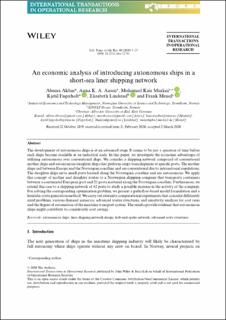| dc.contributor.author | Akbar, Abeera | |
| dc.contributor.author | Aasen, Anna Kristine Almestad | |
| dc.contributor.author | Msakni, Mohamed Kais | |
| dc.contributor.author | Fagerholt, Kjetil | |
| dc.contributor.author | Lindstad, Elizabeth | |
| dc.contributor.author | Meisel, Frank | |
| dc.date.accessioned | 2020-04-24T08:22:40Z | |
| dc.date.available | 2020-04-24T08:22:40Z | |
| dc.date.created | 2020-03-16T13:40:48Z | |
| dc.date.issued | 2020 | |
| dc.identifier.issn | 0969-6016 | |
| dc.identifier.uri | https://hdl.handle.net/11250/2652354 | |
| dc.description.abstract | The development of autonomous ships is at an advanced stage. It seems to be just a question of time before such ships become available at an industrial scale. In this paper, we investigate the economic advantages of utilizing autonomous over conventional ships. We consider a shipping network composed of conventional mother ships and autonomous daughter ships that perform cargo transshipment at specific ports. The mother ships sail between Europe and the Norwegian coastline and are conventional due to international regulations. The daughter ships serve small ports located along the Norwegian coastline and are autonomous. We apply this concept of mother and daughter routes to a Norwegian shipping company that transports containers between a continental European port and 21 ports scattered along the Norwegian coastline. Furthermore, we extend this case to a shipping network of 42 ports to study a possible increase in the activity of the company. For solving the corresponding optimization problem, we present a path‐flow‐based model formulation and a heuristic route generation method. We carry out extensive computational experiments that consider differently sized problems, various demand scenarios, advanced routes structures, and sensitivity analyses for cost rates and the degree of automation of the maritime transport system. The results provide evidence that autonomous ships might contribute to considerable cost savings. | en_US |
| dc.language.iso | eng | en_US |
| dc.publisher | Wiley | en_US |
| dc.rights | Navngivelse-Ikkekommersiell 4.0 Internasjonal | * |
| dc.rights.uri | http://creativecommons.org/licenses/by-nc/4.0/deed.no | * |
| dc.title | An economic analysis of introducing autonomous ships in a short‐sea liner shipping network | en_US |
| dc.type | Peer reviewed | en_US |
| dc.type | Journal article | en_US |
| dc.description.version | publishedVersion | en_US |
| dc.source.journal | International Transactions in Operational Research | en_US |
| dc.identifier.doi | 10.1111/itor.12788 | |
| dc.identifier.cristin | 1801857 | |
| dc.description.localcode | © 2020 The Authors. International Transactions in Operational Research published by John Wiley & Sons Ltd on behalf of International Federation of Operational Research Societies This is an open access article under the terms of the Creative Commons Attribution‐NonCommercial License, which permits use, distribution and reproduction in any medium, provided the original work is properly cited and is not used for commercial purposes. | en_US |
| cristin.ispublished | true | |
| cristin.fulltext | original | |
| cristin.qualitycode | 1 | |

